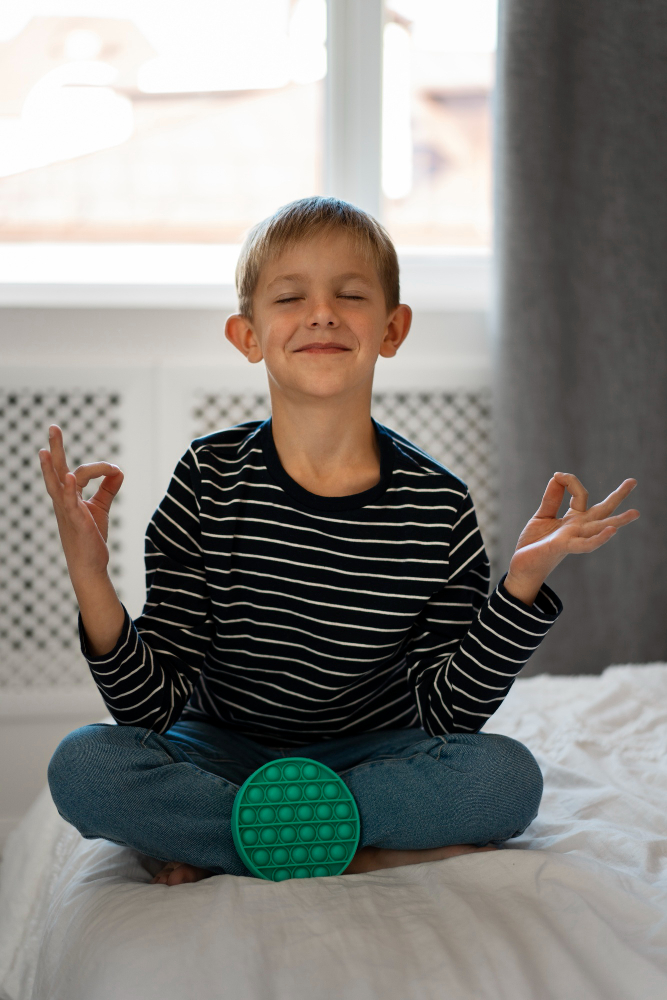Bedtime Meditation for Kids

Introducing bedtime meditation into your child’s nighttime routine can significantly improve their sleep quality and overall health. This practice not only helps settle the mind before bed but also develops long-term habits that foster calmness and emotional resilience.
Our guide offers easy, practical steps to incorporate bedtime meditation for kids, ensuring a smoother transition to sleep and healthier life patterns.
Why Bedtime Meditation Matters for Your Children
The Benefits of Meditation
Bedtime meditation aids children in numerous ways. Primarily, it helps calm the mind, which is particularly beneficial for kids who experience restlessness or anxiety as bedtime approaches.
Regular meditation can also enhance concentration, promote emotional stability, and increase overall happiness. Importantly, these benefits are not just temporary.
Over time, meditation can contribute to developing a more balanced temperament and better stress management skills in children.
Settling Into Sleep with Meditation
For many children, transitioning from a busy day to the quiet of night is challenging. Meditation introduces a period of calmness to their routine, which can facilitate a smoother transition into sleep.
Techniques such as guided imagery, deep breathing, and muscle relaxation are particularly effective. These methods help children slow down their thoughts and relax their bodies, making it easier to fall asleep.
How to Start Bedtime Meditation for Kids
Creating a Conducive Environment
- Quiet Space: Select a quiet corner of your child’s room for meditation. This area should be free from distractions like toys and electronic devices.
- Comfortable Setup: Arrange a comfortable sitting or lying position for your child. Use cushions or a yoga mat to make the space inviting.
- Routine: Incorporate meditation into the nightly routine so that it becomes a habit. This predictability helps children feel secure and eases their stress.
Techniques That Work
- Guided Imagery: Use calm, soothing stories or scenarios that allow children to visualize a peaceful setting, enhancing their relaxation.
- Deep Breathing Exercises: Teach your child to breathe deeply from their abdomen. This method naturally induces calm and is a foundational technique for most meditation practices.
- Progressive Muscle Relaxation: Guide your child through tensing and relaxing different muscle groups, which can significantly help release physical tension and settle into bed.
- Soft Music or White Noise: Background soft music or white noise can enhance the meditative experience by blocking out external disturbances.
Addressing Common Challenges
Keeping Kids Engaged
Meditation should be a calming, enjoyable experience for children. If a child does not seem interested in one method, try another that might be more engaging for them. For instance, some kids prefer stories (audiobooks or a parent’s readings), while others find peace in soft music or white noise.
Duration and Frequency
Start with short sessions, perhaps 5-10 minutes, and gradually increase the duration as your child becomes more accustomed to the practice. Consistency is key, so aim for daily sessions, ideally as part of the bedtime routine.
What Parents Are Saying
Parents often notice improvements not just in their children’s sleep patterns but also in their daytime behaviors and emotional responses. Many report that their children handle emotional situations with greater ease and exhibit increased patience and focus in school.
Conclusion: Embrace the Quiet
Bedtime meditation is a powerful tool for enhancing your child’s nighttime routine and overall well-being. By integrating these practices into their schedule, you can help them achieve a more profound sense of calm and control that benefits many aspects of their lives. We encourage you to try these techniques and see their positive impact.
Share your experiences and insights by commenting below, and don’t hesitate to explore more resources on child wellness that we offer. Let’s make bedtime a peaceful time that benefits the mind and body.
Read More:
Deep Sleep With Guided Meditation Practices
Related Posts

Excel in Online Yoga Classes

Achieving Radiant Skin with The Hot Yoga Glow
About Us


